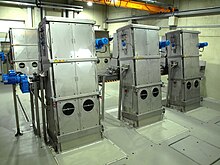Rake (sewage treatment plant)
Rakes or sieves are an important cleaning step in sewage treatment plants . The wastewater flows through a rake or sieve , with which coarse ingredients are retained. The separated substances called screenings or screenings . In terms of process technology, it is a matter of separating solids from a liquid (a sub-area of mechanical process engineering, which also includes filtration ). Rakes and sieves are usually the first cleaning stage in sewage treatment plants. Rakes and sieves are rarely used at the outlet of the sand trap or in the return sludge flow.
Designs
Rakes are classified according to different criteria. The most common distinction to be found is the size and shape of the opening geometry.
A division is also possible according to the type of separation area. Devices with parallel bars are called rakes. Grids, holes or meshes characterize a sieve. Historically the most widespread are bar rakes , but also step rakes . More recent developments increase the computing surface and then have better solids retention due to the low flow velocity through the openings. Sieves are used for higher demands on solids retention. It should be noted, however, that sieving often results in a significantly higher hydraulic loss.
Another distinction is made according to the type of cleaning of the separation surface. There are surfaces that are cleaned by hand and automatic cleaning systems. The automatic cleaning takes place via grippers, chain rakes or eccentric systems. Filters often have movable separation surfaces that are cleaned with brushes and flush bars.
Coarse screens and screens
Coarse screens with an opening size of 20 mm and larger are used to protect the mechanical system parts and to avoid blockages.
Middle rakes and sieves
Middle screens with an opening size of 8 mm to less than 20 mm are also used to protect the mechanical system parts and to avoid blockages.
Fine screens and screens
Fine screens with an opening size of more than 1 mm to less than 8 mm are used to protect sensitive machines and parts of the sewage treatment plant and to reduce the accumulation of solids in the sludge. The aim of using the fine rake is to remove solids as much as possible.
Fine screens and screens
If machines and system parts of the sewage treatment plant that are particularly susceptible to failure, such as membrane systems, have to be protected, fine sieves with an opening size of 0.05 mm to less than 1 mm are used. The separation area is usually completely covered with screenings after a short time. It is therefore more a question of filtration in which particles that are smaller than the opening geometry are also retained.
Microsieves
Microsieves with an opening size of less than 0.05 mm are used for the highest demands on the retention of very fine particles.
Screenings
Screenings have a water content of over 85% immediately after removal. The solid consists mainly of organic substances such as. B. toilet paper, faeces and leftover food. Mineral components such as sand and clay account for 4 to 9%. When using fine screens and fine sieves, sand is increasingly contained. Screenings can contain all types of civilization garbage. This also includes packaging, bits, square timbers and car tires. Fibers contained in wastewater (textile fibers, hair, paper and plastics) are problematic. Due to their structure, they tend to become clogged and can damage pumps and stirrers. The wet wipes and fleeces that have been used more and more frequently in recent times are particularly problematic ; in contrast to normal toilet paper, they do not dissolve or dissolve only insufficiently in the sewer. The woven-in plastic fibers are extremely tear-resistant and can lead to significant operational problems in pumps and rakes.
In Western Europe, between 5 and 15 liters of scrap pipes per inhabitant and year are removed from domestic wastewater. The washing out of easily soluble organic components and the compaction of the screenings reduce the water content to 50 to 70% and the amount to be disposed of on average to 2.2 kg screenings per inhabitant per year. Depending on lifestyle, the amount can vary greatly in other countries. Screenings are hygienically problematic waste that is not allowed to be deposited in Germany. Therefore, the most common disposal is through composting or incineration.
See also
literature
- Th. Uckschies: Fine screens in wastewater treatment. Springer Vieweg, 2017, ISBN 978-3-658-20021-3 .
- Th. Uckschies: Investigation of the use of fine screens of different types and functions in municipal sewage treatment plants. Dissertation at the University of Luxembourg, (hdl.handle.net)
- M. Kuhn: Quantities and dry residue from screenings of municipal sewage treatment plants. (= Environmental engineering series. Volume 48). Faculty of Agricultural and Environmental Sciences, University of Rostock, 2014, ISBN 978-3-86009-415-0 .
- Fr. Sierp, A. Splittgerber, H. Holthöfer: Water and air. Eighth Volume, Part One: Technology of Water. Published by Julius Springer, Berlin 1939.
- Klaus Görner, Kurt Hübner (Ed.): Environmental protection technology. Springer Verlag, Berlin / Heidelberg / New York 1999, ISBN 3-642-64134-2 .
- DIN 19569-2: Sewage treatment plants - Building principles for buildings and technical equipment - Part 2: Special building principles for facilities for separating and thickening solids (without facilities for separating and treating sand). Beuth-Verlag, Berlin September 2017.
Web links
- Design and operating results of fine screens (accessed on November 10, 2015)

